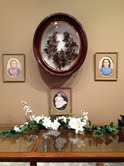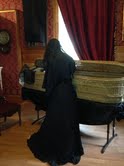There’s still time – a week, in fact – to enter and explore the curious, sometimes heartbreaking, and often impossibly distant world of Victorian Mourning Customs.
Running through Nov. 3 at the Petaluma Historical Museum and Library, this intriguing exhibit offers a look at the era of Queen Victoria – approximately 1880 through the early years of the 20th century. The customs of the time are so far removed from those of our time it can seem as though they’re from a different planet.
Visitors may be tempted to dismiss some parts of the exhibit as being creepy, macabre or weird, but it’s important to understand the time period, said Solange Rusek who created the exhibit with Teresa Froschl and Barbara Maxwell.
It was a world where death was common. The twin miracles of vaccines and antibiotics were decades in the future. Mortality, especially among children, was tragically common. In four days in February, 1879, three little Petaluma girls – sisters Emily, Helen and Amelia Sherman – died of diphtheria. They were memorialized in an elaborate, lacy wreath of their hair. It’s important to realize, Rusek said, that items such as hair wreaths, mourning clothes and special jewelry were signs of affection and respect. Creating the wreath out of a person’s hair brought the loved one closer.
 While much of the research that went into the exhibit was obtained via the Internet, items such as mourning clothes and jewelry, and historic items from local funeral homes were loaned or donated to the museum, Rusek said.
While much of the research that went into the exhibit was obtained via the Internet, items such as mourning clothes and jewelry, and historic items from local funeral homes were loaned or donated to the museum, Rusek said.
Because a number of Petaluma pioneers hailed from New England, the exhibit focuses primarily on the formerly English mourning customs of those ancestors.
Rusek talked about the societal differences between the mourning periods for wives and husbands. If a husband died, a wife could be in mourning between three and six years, depending on her social position. However, if a wife died, her husband generally was in mourning between six months and a year. The death of a child usually meant a mourning period of three months.
These were slower times, she pointed out. Grief was acknowledged, and those who were bereaved were given time to heal.
She pointed out how the various stages of mourning for a widow were shown by what she wore. Immediately after death, she would wear a plain black dress of crape or bombazine. These fabrics lacked shine or luster and provided a solemn appearance. As she moved through the mourning process, Rusek said, decorative jet beading was added. This denoted respect—that the widow would take the time do the elaborate work.
A part of the exhibit that may trouble viewers are the postmortem portraits – photos of corpses taken after the person’s death. But again, taking the custom in context, the viewer can understand what a gift photography was – although the loved one was gone, the photo would be treasured.
Part of the exhibit is a mourning parlor, a section of the museum furnished as a dead room – as opposed to a living room. Mirrors are covered as mourners are not supposed to be interested in how they look, Rusek said. The clock is stopped at the time of death. At the entrance is a tray of funeral biscuits. These were wrapped, like souvenirs, she said, for those who came to pay their respects.
* * *
On the exhibit’s closing day, Sunday, Nov. 3, a free seminar is offered from 2-3:30 p.m. on how those of us today deal with death, dying and illness. Rabbi Ted Feldman will lead the discussion and there will be representatives from Hospice and other organizations to look at how to prepare for the future.
Museum hours are 10 a.m.-4 p.m. Thursdays through Saturdays; noon-3 p.m. Sundays. The museum is at 20 Fourth St. Visit petalumamuseum.com or call 778-4398.
Mourning superstitions
● Never wear anything new to a funeral, especially shoes.
● Cover your mouth while yawning, so your spirit does not leave you and the devil can’t enter your body.
● A dog howling at night when someone is sick is a bad omen. This can be reversed by reaching under the bed and turning over a shoe.
